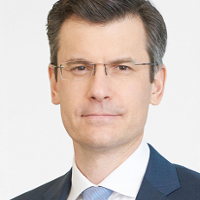Global Chief Investment Officer UBS Mark Haefele
Protecting your portfolio in a more uncertain world

Mark Haefele ist Global Chief Investment Officer der Schweizer Großbank UBS. Foto: UBS
Volatility returned in the first half of 2018, driven by less synchronized global growth, the market´s re-pricing of the Federal Reserve´s hiking schedule, an unexpectedly strong US dollar, escalating trade tensions, and Chinese deleveraging. Looking ahead to the second half, these sources of volatility remain. But it´s important to stay invested.
We see five courses of action to consider:
1. Looking to alternatives. Changes in interest rate expectations could
cause equities and bonds to move up and down together, as we saw at times in the first half. Less-correlated investments such as smart beta,
hedge funds, or private market impact investments can help diversify your
portfolio against exposure to this risk.
2. Hedging equities. If you don't, you're exposed to any of the various
shocks from trade, China, or interest rates that could materialize. So look to protect your portfolio with positions that can help protect against downside risk, while keeping your exposure to potential...
Märkte bewegen Aktien, Zinsen, Politik. Und Menschen. Deshalb präsentieren wir dir hier die bedeutendsten Analysen und Thesen von Top-Ökonomen - gebündelt und übersichtlich. Führende Volkswirte und Unternehmensstrategen gehen den wichtigen wirtschaftlichen Entwicklungen clever und zuweilen kontrovers auf den Grund.
Da diese Artikel nur für Profis gedacht sind, bitten wir Sie, sich einmalig anzumelden und einige berufliche Angaben zu machen. Geht ganz schnell und ist selbstverständlich kostenlos.
We see five courses of action to consider:
1. Looking to alternatives. Changes in interest rate expectations could
cause equities and bonds to move up and down together, as we saw at times in the first half. Less-correlated investments such as smart beta,
hedge funds, or private market impact investments can help diversify your
portfolio against exposure to this risk.
2. Hedging equities. If you don't, you're exposed to any of the various
shocks from trade, China, or interest rates that could materialize. So look to protect your portfolio with positions that can help protect against downside risk, while keeping your exposure to potential market upside.
3. Improving credit quality, but extending duration. In other words,
selling excessive holdings of high yield and buying better quality longerterm bonds. If you don't you risk being over exposed to an asset that could suffer from illiquidity if the cycle turns. High quality longer term bonds have lower default risk and provide counter-cyclical exposure. Multilateral development bank bonds are one option.
4. Diversifying single stock or country-concentrated positions. If
you don't, you're exposed to any number of idiosyncratic events that
could materialize. Mini-crises in Argentina, Brazil, Italy, and poor market
performance even from stable countries like Switzerland in the first half
showed the risks of not diversifying.
5. Investing in assets exposed to secular trends. Investors who are
concerned about market risks and the end of the economic cycle, but
still seek portfolio growth could look to companies benefiting from more
predictable drivers such as population growth, aging, and urbanization, or
companies improving their governance standards. Investors with a longterm focus can also earn higher returns by forgoing liquidity, through
investment in private equity.
Wie hat Ihnen der Artikel gefallen?
Über den Autor















